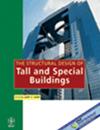连续爆炸荷载细部对钢筋混凝土梁爆炸性能的影响
IF 1.3
3区 工程技术
Q3 CONSTRUCTION & BUILDING TECHNOLOGY
引用次数: 0
摘要
摘要本研究的目的是研究连续爆炸荷载细部对钢筋混凝土梁爆炸性能的影响。首先,通过考虑距离、装药质量对破坏状态和结构响应(位移和支撑反力)的影响,讨论了两次相同爆炸连续加载的影响。在TNT总装药质量为1 kg不变的情况下,分别在RC梁上连续加载2个0.5 kg TNT和1个1 kg TNT,考察了加载次数的影响。此外,还考虑了两次不同爆炸的连续加载,研究了加载顺序和第一次爆炸引起的预损伤对RC梁最终累积损伤的影响。最后,基于反力和位移响应,建立了动残余承载力与累积残余位移之间的非线性关系,用于评价试验梁的损伤状态。结果表明:在第一次爆炸荷载作用下,沿梁跨方向的局部破坏范围(剥落长度和碎裂长度)在二次爆炸荷载作用下没有明显增大;随着爆炸次数的增加,压缩破碎深度逐渐增大。在相同的距离(从0.25到0.45米),由于损伤累积效应,连续加载两个0.5 kg TNT可以触发更严重的局部破坏,但比单次加载1 kg TNT更小的累积残余挠度。另外,在试验梁上加载两种不同爆炸荷载时,先大后小的加载顺序(1 kg TNT/0.5 kg TNT, h = 0.45 m)比相反的加载顺序(0.5 kg TNT/1 kg TNT, h = 0.45 m)对梁的损伤更大。由于纵向钢筋的残余应变,在较小的爆炸荷载的第一次加载之后,梁上的第二次爆炸荷载可能会触发更刚性的行为。基于残余承载力与残余位移之间的非线性关系,将钢筋混凝土梁的累积损伤主要分为四个阶段。本文章由计算机程序翻译,如有差异,请以英文原文为准。
Effect of load details of the successive explosions on the blast behaviors of reinforced concrete beams
Summary The objective of this study was to study the effect of load details of successive explosions on the blast behaviors of reinforced concrete (RC) beams. First, the effect of the successive loading of two identical explosions was discussed by considering the influences of standoff distance, charge mass on the failure states, and structural responses (displacement and support reaction force). And keeping the total TNT charge mass of 1 kg unchanged, the effect of loading numbers was investigated by loading two 0.5 kg TNT successively and a single 1 kg TNT on RC beams, respectively. Besides, the successive loading of two different explosions was also considered by investigating the effects of loading sequences and the first explosion induced pre‐damage on the ultimate accumulated damage of RC beams. At last, based on the reaction force and displacement responses, a nonlinear relationship between the dynamic residual load‐carrying capacity and the accumulated residual displacement was obtained to assess the damage states of the tested beams. The results show that the local failure range along the beam span direction (length of peeling‐off and length of spallation) caused by the first blast load did not apparently increase when the damaged beams were subjected to another blast load. With the increase in explosion numbers, depth of compressive crushing increases gradually. At the same stand‐off distance (from 0.25 to 0.45 m), due to the damage accumulation effect, successive loading of two 0.5 kg TNT can trigger more severe local failure but smaller accumulated residual deflection to beams than the single loading of a 1 kg TNT. Besides, when two different blast loads are loaded on tested beams, the loading sequence of the larger one first and then the smaller one (1 kg TNT/0.5 kg TNT at h = 0.45 m) can trigger larger damage to beams than the opposite loading sequence (0.5 kg TNT/1 kg TNT at h = 0.45 m). And for the beams subjected to a smaller blast load first and then a larger one, a stiffer behavior may be triggered by the second blast load on the beam after the first loading of the smaller blast load due to the residual strain in longitudinal reinforcement. Furthermore, based on the nonlinear relationship between residual load‐carrying capacity and residual displacement, the accumulated damage of RC beams was divided into mainly four phases.
求助全文
通过发布文献求助,成功后即可免费获取论文全文。
去求助
来源期刊
CiteScore
5.30
自引率
4.20%
发文量
83
审稿时长
6-12 weeks
期刊介绍:
The Structural Design of Tall and Special Buildings provides structural engineers and contractors with a detailed written presentation of innovative structural engineering and construction practices for tall and special buildings. It also presents applied research on new materials or analysis methods that can directly benefit structural engineers involved in the design of tall and special buildings. The editor''s policy is to maintain a reasonable balance between papers from design engineers and from research workers so that the Journal will be useful to both groups. The problems in this field and their solutions are international in character and require a knowledge of several traditional disciplines and the Journal will reflect this.
The main subject of the Journal is the structural design and construction of tall and special buildings. The basic definition of a tall building, in the context of the Journal audience, is a structure that is equal to or greater than 50 meters (165 feet) in height, or 14 stories or greater. A special building is one with unique architectural or structural characteristics.
However, manuscripts dealing with chimneys, water towers, silos, cooling towers, and pools will generally not be considered for review. The journal will present papers on new innovative structural systems, materials and methods of analysis.

 求助内容:
求助内容: 应助结果提醒方式:
应助结果提醒方式:


